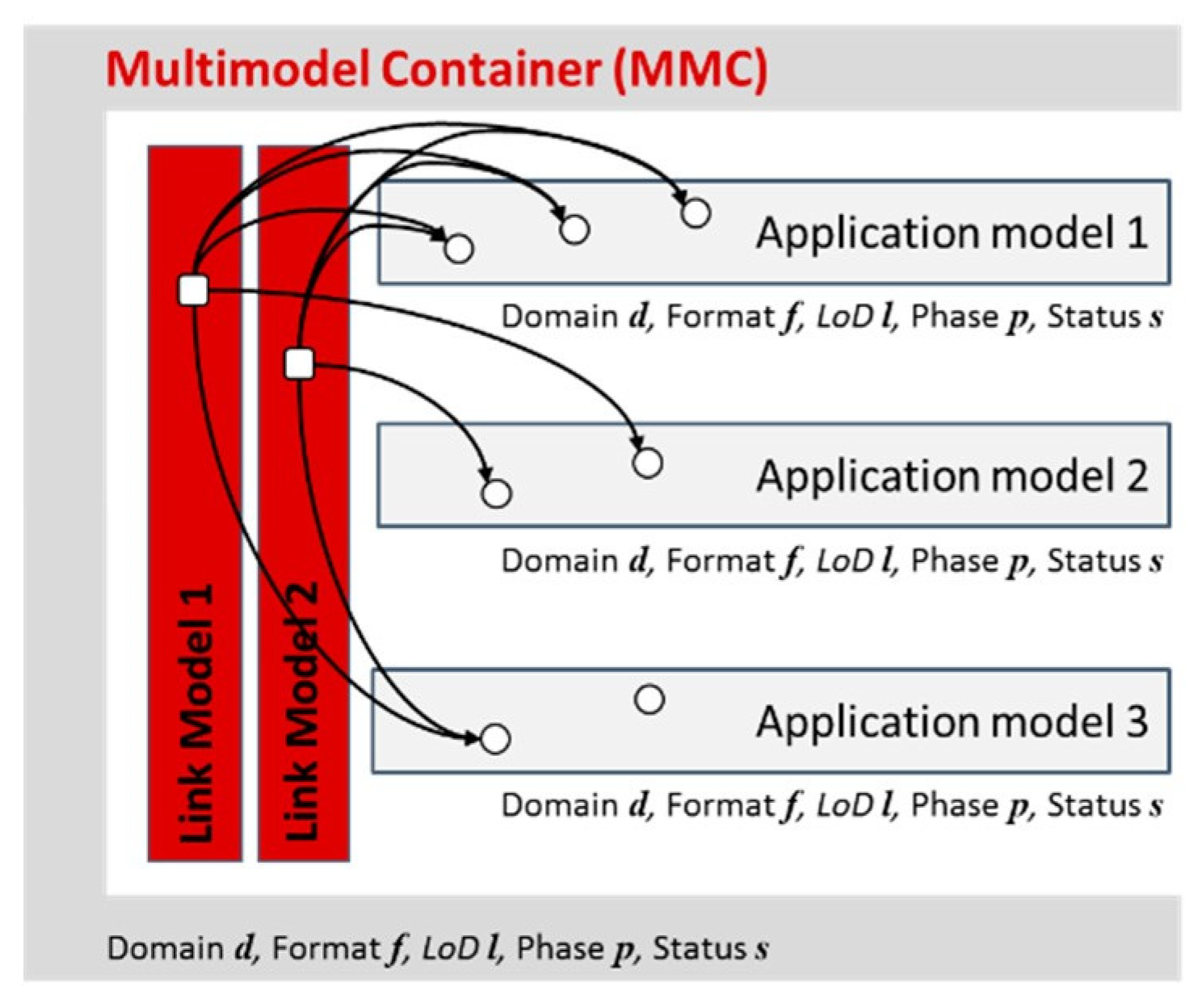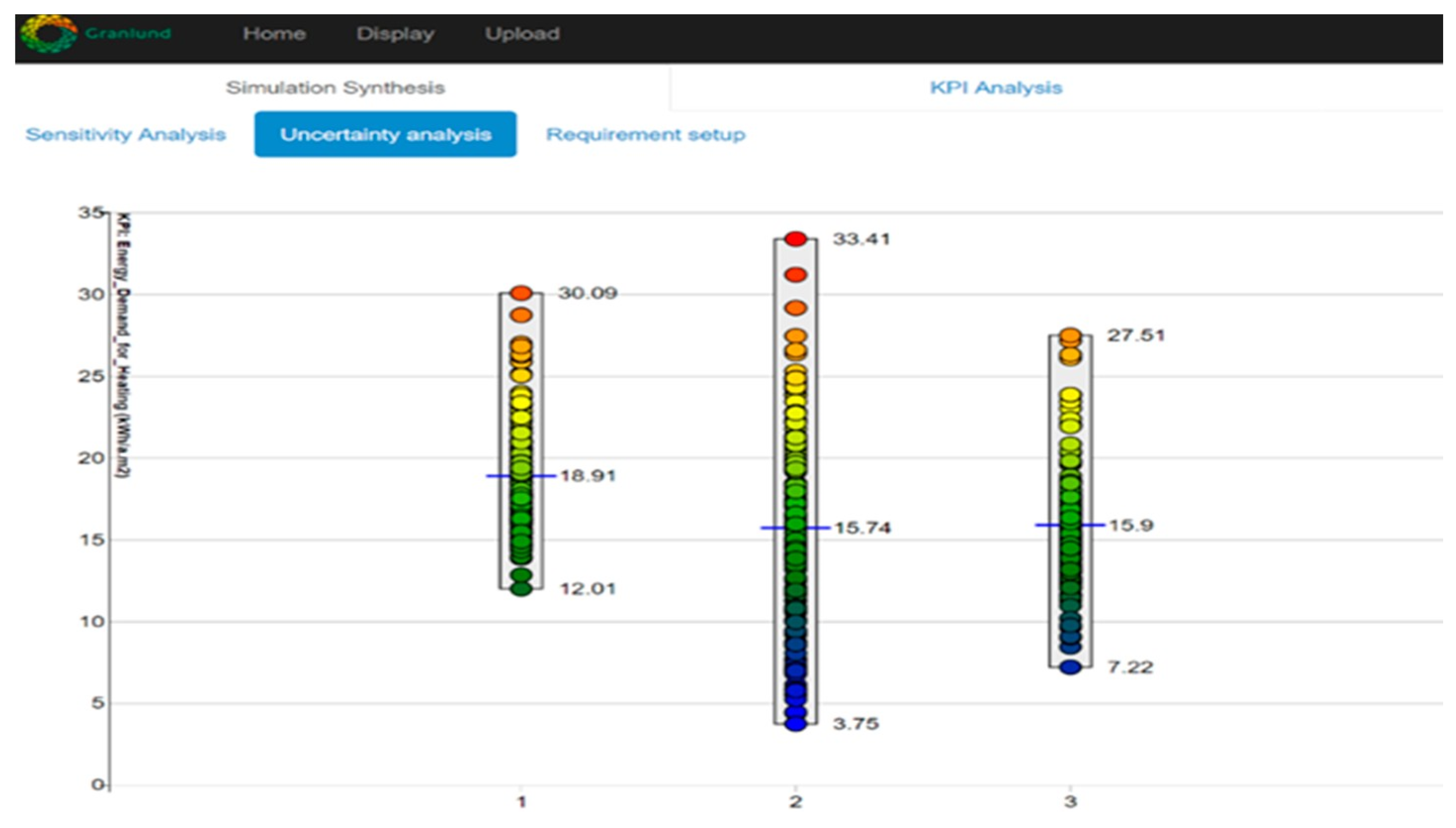1. Introduction
The building design process aims at developing a product that best fulfills the performance requirements of future users. To quantify them, experts typically use a variety of simulation tools that are well established on the market. While every project is tackled as an optimization problem involving multiple performance criteria, there is a growing need of rapidly evaluating, already in early stages, many different design options to find the best alternative. The reliability of such an evaluation is always a critical point because of uncertainty associated with the building design. Such uncertainty is related both to design unknowns reflecting the actual level of development (LOD) and to the stochastic nature of the building life cycle.
This research work presents an innovative modeling approach that supports analysis of uncertainty by several building design options produced in a collaborative building design workflow. In this workflow, several disciplines share information from different data models and formats. This multidisciplinary information is then used as input in building energy analysis (BEA) for detailed results (e.g., geometry, energy infrastructure, weather, building usage…). For that purpose, the approach builds upon the multimodel method [
1]. It enables interlinking data from heterogeneous domains and in different data formats into a consistent information set, called multimodel. This background multimodel method is extended for a broad exploration of building design options and their inherent uncertainty.
2. Materials and Methods
2.1. Multimodel Method
nD modeling initiated the implementation of BIM, and since, many software techniques and tools have been developed so far. However, even if the 3D building model can be extended within a same system with some more informational dimensions like time and cost, it is still not sufficient to integrate the full amount of domain-specific information that every building project engages. Several project partners will still use singular data models specifically optimized for their application domains. For this reason, the multimodel method was developed.
The principle of a multimodel is to combine data models from distinct native data formats, so- called application models, in a single exchangeable information resource named multimodel container. Among application models, the IFC CAD building model [
2] is commonly used as central model. For the energy simulation mentioned in chapter 3, additional application models complement this geometrical product model e.g., an energy system information model (ESIM), a library of generic product templates, a climate and an occupancy model. Data between the different application models are semantically connected and those connections are necessary for performing energy simulation. In order to model them, the multimodel container includes one or more link models. Their purpose is to explicitly associate items from different application models in links adding certain metadata that describe this association.
Figure 1 below illustrates the content of a multimodel container.
2.2. Variation Model for an Extended Multimodel Method
During the design process numerous changes are made by designers thus producing numerous model versions. In this context, we introduce the concept of variant which consists of a set of variations in BIM respectively multimodel data that are made with the aim of analyzing and comparing different design solutions. That way, the design can be optimized in an incremental manner thus letting the decision maker select after each analysis best design candidates with the aim of getting always closer to building design optima. Three types of multimodel variants were defined:
Design Alternatives represent building designs that contain substantial geometric and/or semantic differences between them e.g., a higher number of storeys, another energy system technology or another building shape. Those alternatives are represented by single IFC models.
Design variants represent design options configured on the basis of one design alternative e.g., different types of windows or walls. Configuring variants relies on the use of additional non- IFC data contained in other application models (ESIM, product templates, occupancy...). The content of those additional application models is then interlinked with the IFC model using link models.
Stochastic realizations are generated by a sampling service (
Figure 2) on the basis of one design variant. They describe several scenarios of the building life cycle that depend on its aleatory uncertainty. Unlike design variants which are configured manually by an end user, the stochastic realizations are generated automatically by the sampling service. In the presented example, the stochastic realizations are composed of a set of time series of climate and occupancy variables [
3].
As the amount data can increase drastically through the creation of design alternatives, variants and stochastic realizations, a variation model has been developed as an extension to the multimodel method for describing data variations, coordinating simulations and avoiding information redundancy. That way, one single multimodel resource represents not only one BIM design but multiple design options as well as numerous scenarios induced by aleatory uncertainty. The model does not include domain-specific vocabulary but define only fundamental concepts for varying information. It can describe variations of all type of data at attribute, object, file or resource level.
3. Results
In a use case of an office building a test collaborative design workflow has been implemented. After processing of multimodel information, the simulation [
4] provides a set of KPI values. Below (
Figure 3), the generated KPIs were the energy demand for heating (kWh/m2/year) for three design variants.
The picture lets notice substantial differences between the three variants which differ from their energy system technology (district heating, natural gas boiler, biomass boiler), window-to-wall ratio and other architectural properties. The second one shows less robustness with regard to uncertainty. Despite higher mean value, both other alternatives present less volatility in the yearly use of energy.
4. Discussion
In engineering two types of uncertainty are distinguished, the aleatory and the epistemic uncertainty. Aleatory uncertainty has a random character while epistemic uncertainty is introduced by unknowns. Basically, uncertainties are characterized as epistemic, if the modeler sees a possibility to reduce them by gathering more information. On the contrary, uncertainties are categorized as aleatory if the modeler does not foresee the possibility of reducing them. Considering the effect of uncertainty on building energy performance it is commonly recognized that three main categories of parameters contribute the most to energy simulation outcomes and are the most uncertain at the same time. These are thermo-physical properties like material properties, climate, occupancy and occupant behavior, which all have an intrinsic aleatory uncertainty. Besides the aleatory uncertainty, the design-related uncertainty associated to a certain LOD represents for its part the most contributing epistemic uncertainty. This uncertainty can be appraised by the amount of possible and available design options which will for each have different performances e.g., in terms of energy.
The presented method offers the possibility to analyze both types of uncertainty by exploring their respective information spaces. The epistemic uncertainty is explored by enabling an easy configuration and analysis of numerous design variants. These can then be compared with each other against several performance criteria, thus letting a decision maker or a designer select best design options. Repeating such design choices within the design workflow reduces stepwise the epistemic design uncertainty. The aleatory uncertainty is explored by each design variant by generating stochastic realizations that each represent one building life cycle scenario. That way the effect of aleatory uncertainty on certain performance criteria can be evaluated and can even drive the design choices thus favoring most robust design variants.
5. Conclusions
The goal of the presented extended multimodel method is to fasten and facilitate setting and simulation of numerous BIM variants and uncertainties. It can be further applied to other analysis types e.g., sensitivity analysis or domains e.g., structural analysis, reliability analysis or computational fluid dynamics. Because of the high computational effort induced by numerous simulations, coupling the method with cloud-computing technologies represents promising complementary research.







